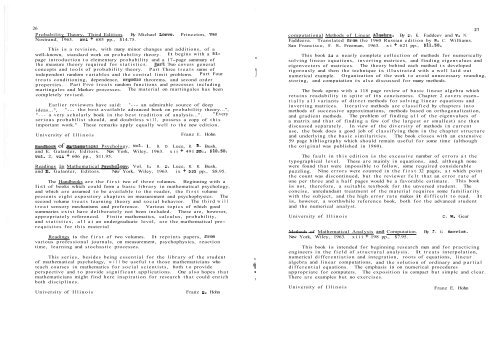Vol. 4 No 1 - Pi Mu Epsilon
Vol. 4 No 1 - Pi Mu Epsilon
Vol. 4 No 1 - Pi Mu Epsilon
Create successful ePaper yourself
Turn your PDF publications into a flip-book with our unique Google optimized e-Paper software.
26Probability Theory, Third Edition. By Michael Loeve. Princeton, Van<strong>No</strong>strand, 1963. xvi + 685 pp., $14.75.This is a revision, with many minor changes and additions, of awell-known, standard work on probability theory. It begins with a 51-page introduction to elementary probability and a 17-page summary ofthe measure theory required for statistics. Part Two covers generalconcepts and tools of probability theory. Part Three treats sums ofindependent random variables and the central limit problems. Part Fourtreats conditioning, dependence, ergodic theorems, and second orderproperties. Part Five treats random functions and processes includingmartingales and Markov processes. The material on martingales has beencompletely revised.Earlier reviewers have said: "... an admirable source of deepideas...", "... the best available advanced book on probability theory...",' a very scholarly book in the best tradition of analysis...". "Everyserious probabilist should, and doubtless will, possess a copy of thisimportant work." These remarks apply equally well to the new edition.University of IllinoisFranz E. HohnHandbook of at he ma tical Psychology, vol. 1. R. D. Luce, R. R. Bush,and E. Galanter, Editors. New York, Wiley, 1963. xii + 491 pp., $10.50.vol. 2, vii + 606 pp., $11.95.Readings & Mathematical Psvchol~, <strong>Vol</strong>. 1. R. D. Luce, R. R. Bush,and E. Galanter, Editors. New York, Wiley, 1963. ix + 535 pp., $8.95.The Handbooks are the first two of three volumes. Beginning with alist of books which could form a basic library in mathematical psychology,and which are assumed to be available to the reader, the first volumepresents eight expository chapters on measurement and psychophysics. Thesecond volume treats learning theory and social behavior. The third willtreat sensory mechanisms and preference. Various topics of which goodsummaries exist have deliberately not been included. These are, however,appropriately referenced. Finite mathematics, calculus, probability,and statistics, all at an undergraduate level, are the mathematical prerequisitesfor this materialReadings is the first of two volumes. It reprints papers, fromvarious professional journals, on measurement, psychophysics, reactiontime, learning and stochastic processes.This series, besides being essential for the library of the studenta>of mathematical psychology, will be useful to those mathematicians whoteach courses in mathematics for social scientists, both to provideperspective and to provide significant applications. One also hopes that Ãmathematicians might find here inspiration for research that could enrichIboth disciplines.University of Illinois Franz E. Hohn,computational Methods of Linear Alqebra. By D. K. Faddeev and V. N.Faddeeva. Translated £ra the 1960 Russian edition by R. C. Williams.San Francisco, W. H. Freeman, 1963. xi + 621 pp., $11.50.This book is a nearly complete collection of methods for numericallysolving linear equations, inverting matrices, and finding eigenvalues andeigenvectors of matrices. The theory behind each method is developedrigorously and then the technique is illustrated with a well laid outnumerical example. Organization of the work to avoid unnecessary rounding,storing, and computation is also discussed for many methods.The book opens with a 118 page review of basic linear algebra whichretains readability in spite of its conciseness. Chapter 2 covers essentiallyall variants of direct methods for solving linear equations andinverting matrices. Iterative methods are classified by chapters intomethods of successive approximations, methods based on orthogonalization,and gradient methods. The problem of finding all of the eigenvalues ofa matrix and that of finding a few (of the largest or smallest) are thendiscussed separately. In view of the diversity of methods in currentuse, the book does a good job of classifying them in the chapter structureand underlying the basic similarities. The book closes with an extensive59 page bibliography which should remain useful for some time (althoughthe original was published in 1960).The fault in this edition is the excessive number of errors at thetypographical level. These are mainly in equations, and, although nonewere found that were impossible to follow, some required considerablepuzzling. Nine errors were counted in the first 32 pages, at which pointthe count was discontinued, but the reviewer felt that an error rate ofone per three and a half pages would be a favorable estimate. This bookis not, therefore, a suitable textbook for the unversed student. Theconcise, unredundant treatment of the material requires some familiaritywith the subject, and the high error rate makes it difficult to read. Itis, however, a worthwhile reference book, both for the advanced studentand the numerical analyst.University of Illinois C. W. Gear-- Methods of Mathematical Analysis + Computation. By J. G. Herriot.New York, Wiley, 1963. xiii + 198 pp., $7.95.This book is intended for beginning research men and for practicingengineers in the field of structural analysis. It treats interpolation,numerical differentiation and integration, roots of equations, linearalgebra and linear computations, and the solution of ordinary and partialdifferential equations. The emphasis is on numerical proceduresappropriate for computers. The exposition is compact but simple and clear.There are examples but no exercises.University of IllinoisFranz E. Hohn
















